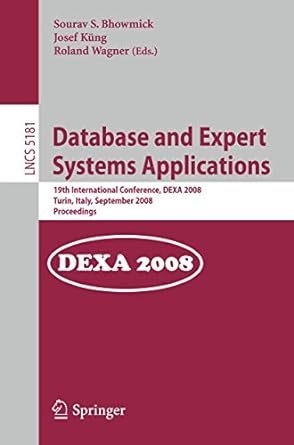Answered step by step
Verified Expert Solution
Question
1 Approved Answer
COP 4 5 3 0 - 0 0 0 4 . su 2 4 Assignment # 1 ; Getting started with linked lists Assignment #
COPsu
Assignment #; Getting started with linked lists
Assignment #; Getting started with linked lists
Due Friday by :pm Points Submitting a file upload Available until May at :pm
COP
ASSIGNMENT #; GETTING STARTED WITH LINKED LISTS
Programming Assignment #
Objective
This assignment will provide practice with a doublylinked list, along with practice on the basic concept of an iterator over a container.
Task
For this assignment you will implement a templated doublylinked list class, along with an associated iterator class for helping with generic list traversals. In a doublylinked list, each node has a pointer to the next node AND a pointer to the previous node. The following starter files are provided for you:
tnode.h fully defines a templated node class for use in a doublylinked list.
Note that the member data includes a data element, as well as pointers to the
next and previous nodes.
tlist.h provides the declarations of the template classes TList the linked
list class and TListIterator an associated class to help with list traversal
driver.cpp contains some sample test calls to the linked list, but should not
be considered a complete or thorough set of tests. You will need to create more
test cases to fully test your class features. This driver is provided to help
illustrate some of the basic class features and concepts, including the use of
iterators.
driveroutput.txt contains the output from running the above sample driver
program.
Your job will be to finish this templated set of classes by defining each of the
functions in the TList and TListIterator classes. These should be defined in a file
called: tlist.hpp
Note that there is already a #include at the bottom of tlist.h where your definition
file will be brought in This illustrates a pretty standard format for setting up a
templated class.
Iterators:
The small class called TListIterator is a helper class that can be used in conjunction
with the linked list class. This is a common feature used in container classes like this.
The purpose of an iterator is to provide a common and nonimplementationspecific
way of traversing a container, so that multiple containers could potentially use
common algorithms like sorting and searching functions, for example This will be
explored more in the course. For the iterator class in this assignment, here is a brief
sample use:
suppose that L is a linked list storing ints, and it has
already been populated with the values
this call would retrieve a list iterator over the container L
TListIterator itr LGetIterator;
at this point, itr currently is positioned at the first element in
the list the
int x itr.GetValue; x would now store
itr.Next; itr has advanced to the
int y itr.GetValue; y would now store
itr.Next;
itr.Next; we have now advanced to the
int z itr.GetValue; z now stores
itr.Previous; now we have moved backwards, to the
int a itr.GetValue; a stores etc.
This class essentially helps us walk through the linked list in a fairly easy way, with
calls to Next and Previous to move around.
Program Details
Here are general descriptions of the two classes you are to define, along with a general
description of each function's task.
class TList
The member data of this class consists of pointers to the first and last nodes, a size
variable, and a dummy variable of type T that can be used for errorchecking situations. Specifically, some of the functions specify to return a stored data item, but if you encounter a situation like an empty list or other situation where there would not BE a valid data item, you can return a reference to the dummy object instead. This is needed because some such functions are passbyreference so that the retrieved item can be modified by the caller under normal situations
Function Descriptions:
Default constructor creates an empty linked list
TListT val, int num creates a linked list containing "num" copies of the data element "val"
Clear clear out the list, resetting it to an empty list
Big Five
Destructor appropriate cleanup of list, no memory leaks
Copy constructor deep copy
Copy assignment operator deep copy
Move constructor constructor with standard move semantics
Move assignment operator assignment with standard move semantics
Accessors
IsEmpty returns true if the list is empty, false otherwise
GetSize returns the size number of data elements in the list
GetFirst returns the data element in the first node by reference
GetLast returns the data element in the last node by reference
Note that error situations in the last two functions would occur if the list was
empty this what the "dummy" item is for
Endpoint insertremoves
InsertFront insert the dat
Step by Step Solution
There are 3 Steps involved in it
Step: 1

Get Instant Access to Expert-Tailored Solutions
See step-by-step solutions with expert insights and AI powered tools for academic success
Step: 2

Step: 3

Ace Your Homework with AI
Get the answers you need in no time with our AI-driven, step-by-step assistance
Get Started


